
Salix × fragilis, with the common names crack willow and brittle willow, is a hybrid species of willow native to Europe and Western Asia. It is native to riparian habitats, usually found growing beside rivers and streams, and in marshes and water meadow channels. It is a hybrid between Salix euxina and Salix alba, and is very variable, with forms linking both parents.
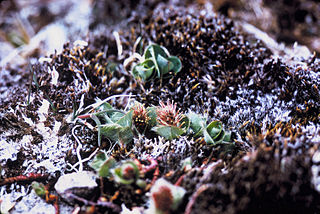
Salix arctica, the Arctic willow, is a tiny creeping willow. It is adapted to survive in Arctic conditions, specifically tundras.

Salix lucida, the shining willow, Pacific willow, red willow, or whiplash willow, is a species of willow native to northern and western North America, occurring in wetland habitats. It is the largest willow found in British Columbia.
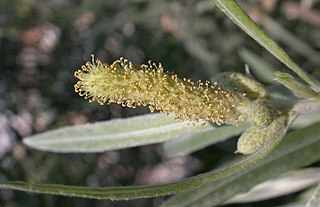
Salix exigua is a species of willow native to most of North America except for the southeast and far north, occurring from Alaska east to New Brunswick, and south to northern Mexico. It is considered a threatened species in Massachusetts while in Connecticut, Maryland, and New Hampshire it is considered endangered.

Salix triandra, with the common names almond willow, almond-leaved willow or black maul willow, is a species of willow native to Europe and Western and Central Asia. It is found from south-eastern England east to Lake Baikal, and south to Spain and the Mediterranean east to the Caucasus, and the Alborz Mountains. It usually grows in riparian habitats, on river and stream banks, and in wetlands.

Salix delnortensis is a species of willow known by the common name Del Norte willow.
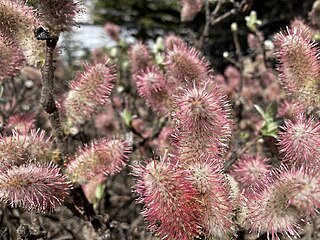
Salix barrattiana is a species of flowering plant in the willow family known by the common name Barratt's willow. It is native to North America, where it is distributed across Alaska and western Canada, with also a few populations in Montana and Wyoming. These disjunct populations are probably relics from a time when the climate was colder. The southernmost population is technically in Wyoming, but it is located at the Montana state line and it is limited to one clone of all-staminate plants within an area of 100 square meters (1,100 sq ft) in a high-elevation habitat.

Salix bebbiana is a species of willow indigenous to Canada and the northern United States, from Alaska and Yukon south to California and Arizona and northeast to Newfoundland and New England. Common names include beaked willow, long-beaked willow, gray willow, and Bebb's willow. This species is also called red willow by Native Americans according to The Arctic Prairies Appendix E by Ernest Tompson Seton.

Salix drummondiana is a species of willow known by the common name Drummond's willow. It is native to western North America from Yukon and the Northwest Territories in the north to California and New Mexico in the south. It is a resident of moist mountain habitats, including forests, riverbanks, and floodplains.
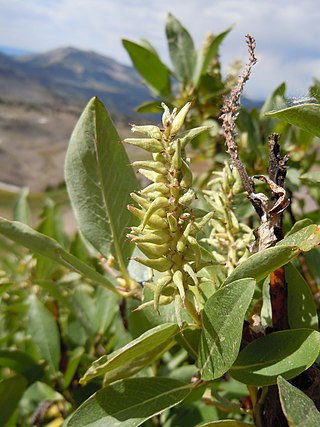
Salix eastwoodiae is a species of willow known by the common names mountain willow, Eastwood's willow, and Sierra willow. It was first described by Bebb in 1879 as Salix californica. This name was later found to be illegitimate, as Lesquereux had given the same name to a fossil willow in 1878.
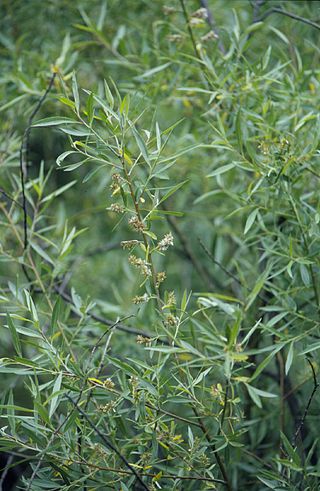
Salix geyeriana is a species of willow known by the common names Geyer's willow, Geyer willow and silver willow. The type specimen was collected by the botanist Karl Andreas Geyer, for whom it was named. Its conspicuous, yellow flowers begin to bloom as early as March, to as late as the end of June.

Salix hookeriana is a species of willow known by the common names dune willow, coastal willow, and Hooker's willow.

Salix jepsonii is a species of willow known by the common name Jepson's willow. it is named for renowned California botanist Willis Linn Jepson.

Salix lutea is a species of willow known by the common name yellow willow. It is native to North America, including central Canada and parts of the western and central United States, with the exception of the Great Basin. It can be found in moist and wet habitat types, such as riverbanks, meadows, and gullies. It is a shrub up to 7 m tall, sometimes forming colonial thickets or becoming erect and treelike. The lance-shaped leaves may grow over 11 cm long and may have smooth, lightly serrated, wavy, or gland-studded edges. The inflorescence is a catkin of flowers up to 4 or 5 cm long, stout to slender in shape.
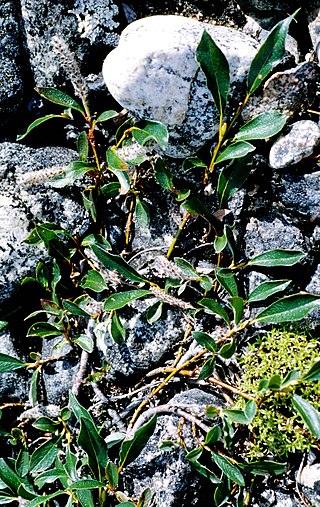
Salix planifolia is a species of willow known by the common names planeleaf willow, diamondleaf willow, and tea-leafed willow. It is native to northern and western North America, including most of Canada and the western United States. It grows in many types of arctic and alpine habitats in the north, and mountainous areas in the southern part of its range.
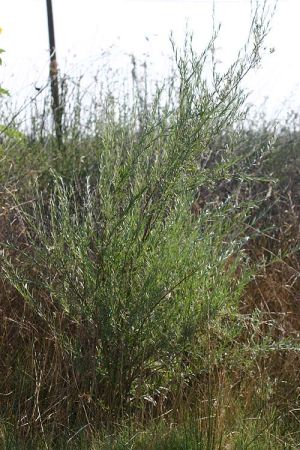
Salix sessilifolia is a species of willow known by the common name northwest sandbar willow. It is native to the west coast of North America from British Columbia and the US states of Washington and Oregon. It grows on sandy and gravelly riverbanks, floodplains, and sandbars.

Salix sitchensis is a species of willow known by the common name Sitka willow.

Salix alaxensis is a species of flowering plant in the willow family known by the common names Alaska willow and feltleaf willow. It is native to northern North America, where it occurs throughout Alaska and northwestern Canada.

Salix arbusculoides is a species of flowering plant in the willow family known by the common name little tree willow. It is native to northern North America, where its distribution extends across Alaska and most of Canada.
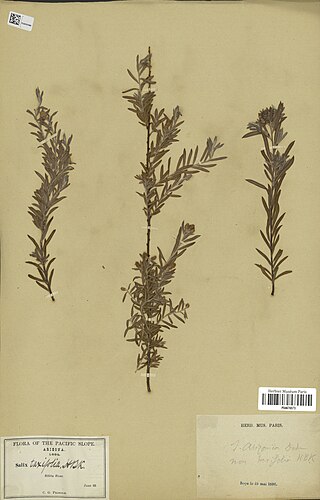
Salix arizonica is a species of willow known by the common name Arizona willow. It is native to the southwestern United States, where it occurs in Arizona, Colorado, New Mexico, and Utah.





















